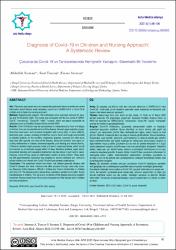| dc.description.abstract | Aim: This study was carried out to summarize the systematic literature review on current
information about Serious acute respiratory syndrome 2 (SARS-CoV-2 or Covid-19 in
children and to determine nursing approach.
Methods: Regarding the research, 156 publications were examined between 21 January and 15 November 2020. The review was conducted with the key words of “SARSCoV-2”, “coronavirus”, “Covid-19”, “child”, “nursing”, which are openly accessible on
databases such as PubMed, Science Direct and the WHO.
Results: Covid-19 infection may be asymptomatic or characterized by fever and fatigue
in children; they can be potential carriers of the disease. Several upper respiratory symptoms have been seen, such as nasal congestion and a runny nose. In some patients,
abdominal pain, nausea, vomiting and diarrhea occurs. Fever and cough were evident
in pediatric patients. As the condition progresses, dyspnea, cyanosis and other signs
may arise after typically one week of the disease, along with systemic toxic signs, including restlessness or malaise, decreased appetite, poor feeding and reduced activity.
Children’s condition might progress quickly and turn to respiratory failure, which cannot
be improved by conventional oxygen within 1-3 days. Metabolic acidosis, septic shock,
irreversible bleeding and coagulation dysfunction can take place in such severe cases.
However, Covid-19 may cause an inflammatory reaction in some children. Those starting with gastrointestinal symptoms may progress to severe conditions and newborns
whose mothers are infected with Covid-19 could have severe complications.
Conclusion: This systematic review has shown that children generally develop mild
Covid-19 disease and these infections are often acquired through community sources. Diagnosis of the disease is difficult in children and there is limited data on children
with Covid-19. The disease mainly causes fever, respiratory symptoms and other flu-like
manifestations in children. The signs and symptoms of the disease should be carefully
monitored. Nurses should know the course and symptoms of the disease well in children
and take precautions. | en_US |


















